ELABORATING THE VULNERABILITY CYCLE
DYSFUNCTIONAL DYADS: Elaborating the Vulnerability Cycle
Don Edwards, Ph.D.

It escapes no one’s notice in observing fighting couples that each partner seems to antagonize the other in exquisite ways in order to inflame the conflict, whether it be open quarrelling, passive aggression or active avoidance. This occurs not just in intimate relationships, but also between friends and among workplace colleagues. Usually these dynamics transcend the subject matter of the dispute; the pattern of conflict is almost always the same.
Self-reinforcing cyclical dyadic interactions have been modelled in several ways by couples therapists:
-
Terry Real (2008) in his Relational Life Therapy (RLT) characterizes this dynamic as the more A Xs, the more B Ys; and the more B Ys, the more A Xs; in other words, a self-reinforcing and never-ending cycle
-
Referencing the family structural theorist, Salvador Minuchin, Esther Perel portrays what goes on as, We make the other; and adds the possibility of ending the drama through an act of self-responsibility: If you want to change the other, change yourself. In other words, what B does that A objects to is (if one looks deep enough) a reaction to what A is doing, and if A wants B to stop doing the ‘objectionable thing,’ it will happen naturally if A makes changes that obviate the detested reaction from B. The change in B may not happen immediately, but eventually the response to A’s change will extinguish because A has removed the trigger. It works both ways in that B could recognize that doing something different might positively influence A. For example, A complains, Stay and help me!, and B leaves. If A requests politely, B might stay. A may still not get all they want (the help), but the aspect that is triggering A (B leaving) may abate. In this frame, let’s coin a new word: desistance, giving up investment in resistance when it is counter-productive. We perhaps can more readily identify a desistance move when it involves an act of commission (e.g., A’s asking politely); but less easily when it involves an act of omission (e.g., B doing nothing –i.e., staying rather than leaving).
-
There some additional richness in the example of A and B: that A’s complaint is double-barreled: to stay and to help. A’s alternate move could be to ask politely as we have noted; but A could as easily be explicit about the help they want. Please hold the ladder while I stand on it sounds a lot more actionable and less emotional and vague than Stay and help me! B is more likely to flee from a vague and emotional sounding request than an explicit factual one. Gestalt therapists call this self-support on the part of A. Marshall Rosenberg’s Non-Violent Communication (2003) has similar guidance around being explicit about requests that have a lot of emotion behind them.
-
Numerous couples therapy commentators have identified three patterns of relationship conflict: i. avoidant couples, ii. high conflict or “escalating” couples, and iii. pursuing / retreating couples. Although the dynamic Real identifies can occur in all three of these patterns, the pursuit and retreat pattern is the most common and best illustrates the pattern of spiraling negativity. In the foregoing example, B’s retreat triggers A’s abandonment fears which prompt A to complain more loudly, causing more retreating by B who is triggered by a perceived attempt to control. The more A complains, the more B retreats; and the more B retreats, the more A complains; and vice-versa. In the escalating couple, the response of each is to up the ante-- a upside-down quid pro quo response on both sides—I don’t like what you did so I’ll do something worse to you! In the avoidant couple, the response of A to dissatisfaction with B is to withdraw of affection or freeze B out, and B does the same in return; both are saying, Two can play this passive-aggressive game.
-
In Stan Tatkin’s Psycho-Biological Approach to Couples Therapy (PACT), none of couples engaging in the aforementioned three conflict patterns have dynamics characterized by secure functioning of the relationship which consists of many elements (Tatkin, 2011). Notably absent in couples in conflict is a key element of secure functioning: the capacity for self-regulation of emotional responses and interactive/mutual regulation (co-regulation) between the partners. These include autonomic internal regulatory elements and as well as voluntary regulation by the higher cortical areas of the brain, if fully developed -- something which, genetics aside, may have been arrested in individuals with trauma histories (Solomon & Tatkin, 2011). The avoidant relationship pattern is characterized by each partner having a pattern of autonomic auto-regulation (a self-focus on managing internal experience with little or no referencing of the other who is more often than not experienced as a source of stress and unpredictability). Certain personality disorders serve an autoregulatory function for the individual. The high conflict relationship pattern is characterized on both sides by external regulation (reliance on the other or on substances for the regulation of emotions) and by inadequate self-regulatory capacity. Pursuing / retreating couples involve a relative difference in self-regulatory capacity, the pursuing partner being more inclined to external regulation, and the retreating partner, to auto-regulation.
-
Scheinkman and Fishbane’s Vulnerability Cycle (2004 ) parses these transactions in to two parts: a trigger that leads to a self-protective reaction or security strategy. In any negative interaction, each party has their own trigger and security strategy. In Scheinkman and Fishbane’s model of the toxic spiral, the security strategy for one is the trigger for the other partner and vice versa.
The following diagram is the basic model of the Vulnerability Cycle:
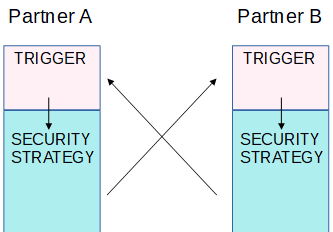
The goal of this article is to parse triggers more finely, embed Vulnerability Cycles in a broader context, and offer an exit strategy from this dynamic that goes beyond simply pointing out to the partners what they are doing.
WHAT DRIVES THE VULNERABILITY CYCLE?
As Esther Perel points out, every relationship is guided by an underlying dynamic tension between the need for connection and the need for autonomy, or belonging versus separateness. It is this dynamic tension that drives the Vulnerability Cycle.
Belonging versus separateness is a polarity (Johnson, 1992). The poles of a polarity are often regarded as problems to solve – You want too much closeness! No, you want too much autonomy!! goes the narrative of a couple fighting. Instead Johnson argues that the extremes of a polarity define the end points of a continuum that can be used profitably if dynamically and flexibly managed. Polarities are inherent in the way our brains work. We all have them, perhaps mine differ from yours, but nevertheless your polarities govern feeling, thought and behaviour even if you are not aware of it. In every polarity there is an energy that drives it. In the polarity of aggression versus depression, the energy is anger, directed either outward (in aggression) or inward (in depression). Terry Real points out that in the polarity of grandiosity versus shame the energy is contempt, directed either outward (in grandiosity) or inward (in shame). In the polarity of relational tension that Perel identifies, the energy is a sense of urgency to manage connection: outbound energy to engage with others versus self-focused energy to attend to self while holding the other at a distance. Every individual needs both connection and autonomy, but differ in degree that they need each, according to what they were most deprived of as children. Misattuned parenting creates anxious, needy, connection-seeking adults who nevertheless still need to experience some degree of autonomy (although they may deny it). Neglectful, distracted, addicted or abusive parenting creates avoidant, self-sufficient, auto-regulating adults who may experience connection as invasive and controlling, but nevertheless still crave it in some degree (although they may deny it). In the pursuit and retreat dynamic, each partner’s feelings, thoughts and behaviour are motivated by their unmet childhood attachment needs, often to the exclusion of awareness that they also need some measure of the opposite pole of the dynamic. Those who most often crave connection, still need some measure of autonomy (though they may be unaware when they inadvertently receive it), and vice versa. Using the pursuit and retreat couple dynamic as an example, Perel points out that “the war is about what the other seems to want too much of” -- too much closeness or too much distance, without recognition that the side-effect of this scuffle is that when B takes distance, A’s separateness need is met (or exceeded), and when A demands connection, B’s need for it is automatically met (or exceeded), as each is seeking more what they didn’t get enough of as a child.
The concept of Trigger in the Vulnerability Cycle does not take into account that there are two components of a triggering situation: something happened or did not happen (the factual component of the situation), plus the interpretation on the part of the perceiver that makes the factual component triggering, or as Terry Real puts it, “what they make up about it.”
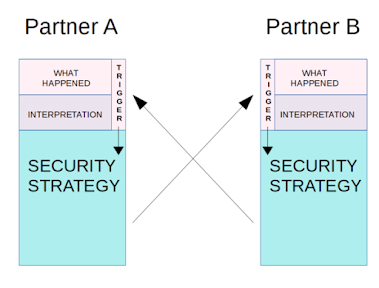
Elaborating this analysis further, it can be noted that the interpretation reflect the person’s attachment history. What A makes up about what B did or did not do is an interpretative act that is informed by A’s attachment history; and vice versa.

EXAMPLES
The following examples explore this in the three couple conflict patterns: i. avoidant couples, ii. high conflict or “escalating” couples, and iii. pursuing / retreating couples.
In an avoidant couple, one gets miffed with the other who retaliates for being snubbed, and the alienation grows as they the attempt to offend from the victim position in ongoing passive-aggressive exchanges. The initiating act may be either a perceived act of intrusion (e.g., asking for something in a way that is perceived as an expectation or control move) or as an act of neglect. The retreating act of passive-aggression may be either self-protective withdrawal / hiding, or withdrawal of connection or affection.
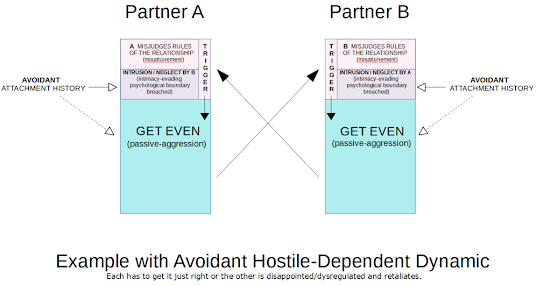
In an escalating couple, the perceived offence sets off a response that ups the ante in order to make the other pay. The underlying motivation – a fear of being abandoned by the other – is usually well hidden.

In pursuit and retreat, the most prevalent pattern in couples conflict, there is an almost elegant playing out of each doing what they habitually do in order to keep safe, but it results in even more of what they are trying to avoid:
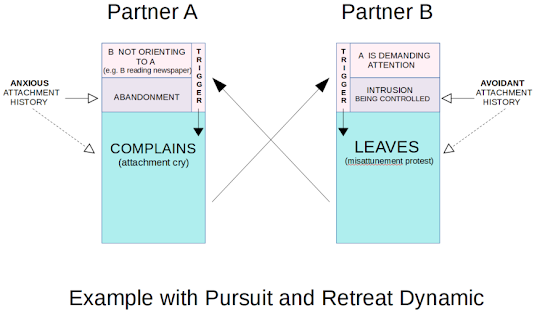
INTERRUPTING THE PATTERN
What is important in this elaboration of the Vulnerability Cycle dynamic is that it points the way to exiting the cycle. The simple version of this solution in Terry Real’s formulation of the problem (the more she Xs, the more he Ys; and the more he Ys, the more she Xs) is the less... the less...; i.e., if each party recognizes what they are doing to fuel the cycle and do even a little less of it, their partner will – even unconsciously – reciprocate unless the dynamic has hardened into hatred and an irreconcilable stalemate.
In the above formulation, consideration of the attachment histories can guide what the corrective needs to be to provoke desistance in the other, or, in the Minuchin-Perel frame, to guide how to change yourself in order to effect change in the other. As Perel points out, your partner cannot continue indefinitely to do what they are doing (unless they are a complete automaton) if you stop doing what evokes that response—i.e., the reinforcement schedule in the cycle of negative dependence is interrupted.
What does desistance look like?
-
avoidant couples: ask yourself if bleak is really fun. Extend to the other, even if it hurts at first.
-
high conflict or “escalating” couples: cool your jets and wait
-
pursuing / retreating couples: do a little bit of the opposite of what you currently do – interrupt the urge to complain/pursue, or, if you are on the avoidant side, stay and show up more.
MORE COMPLEXITY
Referencing the work of Shore and others, Solomon & Tatkin (2011, pp.105-116) offer an overlay to attachment history that takes account of individual differences in reactivity and arousal bias of the nervous system arising from childhood experience and genetics and their epigenetic interaction. They describe three kinds of couples:
-
high-arousal couples have an autonomic bias toward rapid “kindling” leading to impulsivity and extremes extending to passion and mania and to hostility and rage, as well as substance use to self-regulate. Solomon & Tatkin note that such couples often have angry-resistant insecure attachment histories, tending to stay together as both are motivated by a visceral fear of abandonment. These individuals might be described as enmeshed in hostile dependence. Solomon and Tatkin note that reductions in this external regulation are possible through therapy in which new self-awareness and learning new inter-personal responses enhance brain complexity and neuroplastic change, which may foster more secure functioning in the relationship, although the original autonomic biases likely remains unchanged.
-
low-arousal couples have a parasympathetic bias toward low arousal states and usually have avoidant attachment histories, auto-regulate and find high sympathetic states, whether positive or negative, aversive. Solomon and Tatkin note that these individuals were unheld as babies, lack internal means of self-calming and often have problems with sleep, OCD (which serves a distracting function) and hoarding. Their inability to experience mutuality shields them from interpersonal complexity, but leaves them feeling alone and separate in the relationship.
-
biphasic couples are chronically misattuned to one another in terms of their autonomic biases, one biased toward low arousal states and the other, higher arousal states. Their misattunments often lead to frustration and quarrelling. Achieving better attunement will require that both learn to tolerate arousal states differing from their arousal bias and learn how to navigate and moderate the arousal state of the other.
....which brings us to one last diagram illustrating what goes on in couples in conflict:
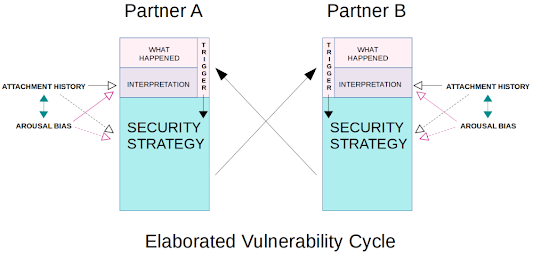
PULLING IT ALL TOGETHER
A FINAL EXAMPLE
A and B are a biphasic couple with a pursuit / retreat dynamic. The dynamic is obscured because A has a secure attachment history. B is disorganized with borderline features. A has a low arousal bias, but as a securely attached individual, A is not frightened by B’s labile moods and high arousal bias. A hangs in and listens, no matter what happens. A is “infuriatingly passive” says B. A’s “retreat” is subtle: A does not rise to match the arousal level of B. A watches and tries to respond attentively and thoughtfully, but to B, the failure to meet at the same level of autonomic arousal signals a disconnect, a misattunement that B equates with abandonment—a feeling of being dropped, and unheard. “You are not there for me! You don’t get me!! Nothing I do is enough!!!” (meaning also that nothing A does is enough), etc. What ensues is an oft-repeated one-sided fight (a passion play put on by B with A watching as an impassive audience). B harangues and demands (pursuit), but A does too little but observe, agree, tread carefully and placate (A’s security strategy - a version of retreat). The fight escalates as A’s calm attentiveness is misread as indifference and exclusion, riling B to ever more elevated outrage, until ultimately at the climax of this passion play, B enacts the histrionic security strategy of checking out -- packing bags with great fanfare and driving off with screeching tires to move home with parents whose house is WW III (autonomic congruence).
What do to? This is the latent/blatant scenario described in Terry Real’s LRT. The latent needs to stand up and the blatant needs to stand down -- easier said than done in this example, the therapist having to confront the borderline blatant with the evidence that histrionics yield the opposite of the connection and intimacy that they berate their partner for failing to provide. Encouraging the latent to manifest a little more energy and enthusiasm when tensions rise is an easier task. Both partners can be helped by bringing awareness to the fact that their episodes of escalating discord have more to do with the mismatch of their emotional tenor than the content of the dispute as evidenced by the observation that the mismatch is a constant no matter what they are fighting about.
CASE CONCEPTUALIZATION AND TREATMENT PLANNING
A colleague remarked how she loved working with couples, Every one is a new puzzle for me! Every example in this paper can be clothed in a puzzling array of differing specifics that make it difficult to discern the underlying pattern. Recognizing what is really going on in the dynamics of a couple is what Terry Real calls the relational diagnosis. This is the case conceptualization that needs to take place in the first session or before the second. Case conceptualization precedes treatment planning. Until the therapist has a sense of what is going on, it is impossible to plan treatment. However, both are works in progress: the case conceptualization is revised by new disclosures from the couple that inform amendments to the treatment plan.
Drawing on the contributions to the field by Real, Perel, Tatkin and others, this paper has provided a variety of lenses to help in the conceptualization of the dynamics of a couple that in turn suggest a focus for treatment. Couples may present with catastrophic issues such as an affair, oppositional children, an addiction, mental illness, etc., as the reason for seeking help, but as riveting as these issues may be, they arose in the context of the kind of dynamics discussed above. These dynamics must be clearly understood by the therapist and delineated for the couple in order for them to understand and transcend their presenting issue.
REFERENCES
Johnson, B. (1992) Polarity Management: identifying and managing unsolvable problems. Amherst, MA: HRD Press.
Real, T. (2008) The New Rules of Marriage: what you need to know to make love work. New York: Ballantine.
Rosenberg, M. B. (2003) Non-Violent Communication: a language of life. Encinitas, CA: PuddleDancer Press.
Scheinkman, M. & Fishbane, M. D. (2004) “The Vulnerability Cycle: Working With Impasses in Couple Therapy.” Family Process, Vol. 43(3), pp.279-299.
Solomon, M. & Tatkin, S. (2011) Love and War in Intimate Relationships: connection, disconnection and mutual regulation in couple therapy. New York: Norton.
Tatkin, S. (2011) Wired for Love. Oakland, CA: New Harbinger.
